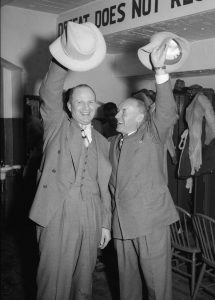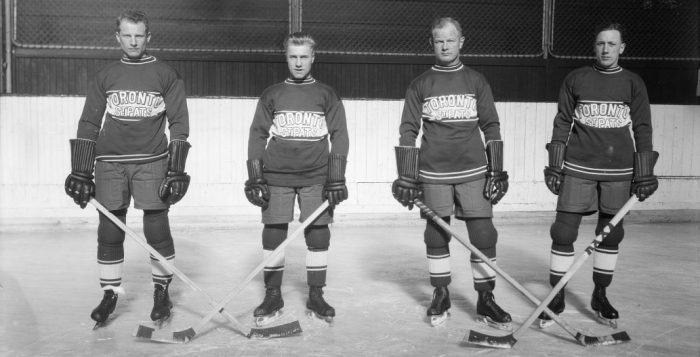This Day in Hockey History – February 1, 1955 – Conn’s “Happy” Day
(Photo: City of Toronto Archives)
If J.P. Bickell hadn’t reached out to see if Conn Smythe might be interested in taking over coaching the struggling Toronto St. Patricks of whom Bickell was the senior member of the partnership that owned the team, it is possible that there may never have been a Toronto Maple Leafs team in the NHL. And who knows if they would have gone on to become as successful as they did or if Clarence Henry “Hap” Day would have had the success he ultimately did even after his playing career ended.
Originally, after having been fired by the New York Rangers, Conn Smythe had gone to Bickell suggesting that he let Smythe coach the Toronto St. Patricks who were having a tough season. Bickell opted instead to hire Mike Rodden. Smythe was not shy in pointing out to Bickell that this would turn out to be a terrible mistake. Smythe would be right. Bickell sought out Smythe and invited him to take over, but by then Smythe didn’t want to just coach. Instead he wanted to own part of the club. Long story short, on February 14, 1927, Smythe and his investors joined Bickell as owners of the club and Smythe was the general manager.
The Maple Leafs were born of tradition and of those who had been with Smythe in the World War I. The emblem chosen for the team sweater was not just an idle selection.
“The Maple Leaf, to us, was the badge of courage, the badge that meant home. It was the badge that reminded us of all our exploits and the different difficulties we got into, and the different accomplishments that we made. It was a badge that meant more to us than any other badge that we could think of, so we chose it, hoping that the possession of this badge would mean something to the team that wore it, and when they skated out on the ice with this badge on their chest, they would wear it with honour and pride and courage, the way it had been worn by the soldiers of the first Great War in the Canadian Army,” shared Smythe during a speech at a Maple Leafs’ banquet in October of 1945.
At the start of his involvement, the St. Patricks were in sad shape. They were last in place in their division having only won 19 of their 31 games, and with the exception Day, the team’s captain, and a rookie in his first season as a professional hockey player named Irvine Bailey (a player who would eventually gain the nickname of “Ace”), the team had nothing to speak of on the bench. After changing the name of the team, they did begin to do a little better, but Smythe would have his hands full in trying to improve the team as well as improve the number of fans who came to see them play.

Conn Smythe and Hap Day
(Photo: City of Toronto Archives)
Smythe and Day would ultimately be involved together both on the ice and off. “Happy” Day as he was called then ended up with a season ending injury during a game against the Montreal Canadiens on February 2nd. Another player stepped on the back of his leg, cutting into his Achilles tendon. It would take him eight months before he could skate again, and his tenacity through the painful rehabilitation earned him not only the respect of Smythe but also 16% ownership in Smythe’s profitable sand and gravel company.
“I wanted him with me summer as well as winter for a long time, which turned out to be one of my best decisions. He was one of the best men I ever met,” Smythe said of his talking Day into the partnership.
Day served as the captain of the team from 1926 through 1936 and played his last season with the New York Americans in 1937-38. From 1938 to 1940 he served as a referee and also did some coaching, but in 1940 he would return to the Toronto Maple Leafs organization when Smythe—after firing Dick Irvin as coach—offered Day the job. Day served in that capacity for ten years, during which time he would become the most successful coach in the NHL. One of his biggest accomplishments was coaching the Leafs team in 1942 when, after finding themselves down three games in the Stanley Cup finals to Detroit, the team rallied to take the next four games and the coveted Cup of Lord Stanley. During his ten years coaching the Leafs he won five Stanley Cups, which included a three-peat from 1947 to 1949.
Day retired from coaching in 1950, but he didn’t leave the Leafs. He became the assistant to the general manager, which was still Conn Smythe. While Smythe continued to be the general manger on paper, in effect on February 1, 1955, Day took over most of the daily operations—though his tenure as general manager with the team would last only until March 25, 1957, when he resigned after Smyth publicly humiliated Day by calling the previous season a “season of failure.” Day was inducted into the Hockey Hall of Fame in 1961.
Sources
- Hockey Hall of Fame, Legends of Hockey: Hap Day Biography
- “Day New GM of Leafs,” Ottawa Journal, February 1, 1955, p. 16.
- D’Arcy Jenish, The NHL: A Centennial History, 100 Years of On-Ice Action and Boardroom Battles (Toronto, Canada: McClelland & Stewart, Ltd., 2013)
- Kelly McParland, The Lives of Conn Smythe, From the Battlefield to the Maple Leaf Gardens: A Hockey Icon’s Story (Toronto: McLelland & Stewart Ltd., 2011).















[…] defenseman had even scored four since Hap Day, also of the Maple Leafs did it against the old Pittsburgh Pirates on Nov. 19, 1929,” stated the […]
[…] Cary Smythe, known around the National Hockey League as Conn Smythe. He is best known as being the principal owner of the Toronto Maple Leafs, originally known as the Toronto St. Patricks until the sale in February 1927 to the group that […]